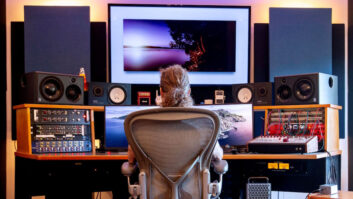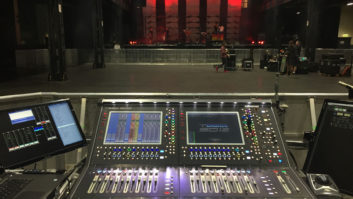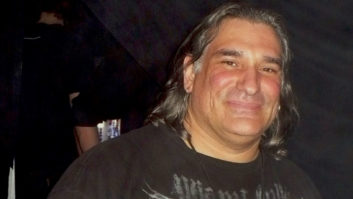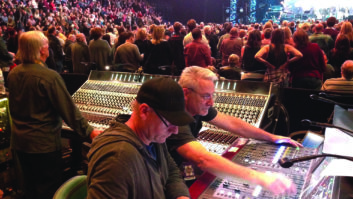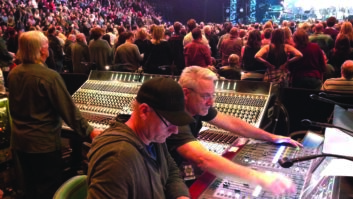“Supposedly, this is the most equipment that any band has ever tried to put onstage here,” explains Nickelback tour manager/FOH engineer Kevin “Chief” Zaruk. Standing on the balcony of San Francisco’s historic Warfield Theater, Zaruk motions toward several mammoth stacks of Marshall and Mesa cabinets and an intricate array of risers and stairs that provide multiple mic positions for lead singer/guitarist Chad Kroeger. “We weren’t even sure we were going to have enough power until about a half hour before soundcheck,” monitor engineer Mark “Sparky” McNeill adds. “We had nothing all day, and then all of a sudden, someone yelled ‘power up,’” he says with a laugh.
Two years ago, no one had really heard of Nickelback; lately, it’s difficult to go anywhere without hearing Nickelback’s signature single “How You Remind Me.” The band’s sudden ascent from Canadian upstarts to their current status as MTV darlings has been a whirlwind ride for both the band and their spry crew, some of whom have been with the band from the start. Zaruk, who had worked with some opening acts on recent Mötley Crüe and Kid Rock outings, did his first tour with Nickelback in 2000 — a tour that began as an opening slot with KISS and turned into a 14-month trial-by-fire.
“We did something like 256 shows that year,” recalls Zaruk. “So we just toured non-stop. And after that, we went back home, had a month off and recorded a new record. And I helped out in the studio, just because I knew their sound so well. And then ‘How You Remind Me’ blows up, and we went from one bus and three crew guys to four semis, four buses and 33 crew guys. So, definitely, things have changed.”
ONE SIZE FITS ALL
For the larger theaters and clubs that the band is hitting on this tour, Zaruk and systems tech Jack Saurez designed a system that can be easily scaled to fit a variety of venues. The main rig consists of V-DOSC, dV-DOSC enclosures and Electrotec subs with BSS 366 crossovers and Klark Teknik DM 3600 EQs — all supplied by Electrotec. The crew typically flies 12 V-DOSC cabinets a side with additional Arc and dV-DOSC sidefill and frontfill. But at the San Francisco gig, which posed a few technical challenges, they were only using six V-DOSC cabinets a side, with one stacked on top of the subs.
“This is an unusual venue because you’re not allowed to set up [the FOH compound] on the floor,” explains Saurez. “So you have to set up upstairs, which is kind of cramped. It’s difficult to mix here because you’re as close to the P.A. as you could possibly be. I like to be farther away. That way, I can reference the back of the room and make sure it’s really clear in the back. So, it’s a little different here.”
Zaruk and Saurez, who share responsibilities at FOH, work on a 48-input Midas XL4 console. The main vocal mic — singer/guitarist Kroeger’s Shure Beta 58 — is routed though a Neve compressor and various multi-effects. “Chad’s favorite, actually, is the Beta 58,” Saurez explains. “We’re trying a couple of things out, like a Neumann, which he’s using right now on the bus and in the studio, and he seems to like it. But he really likes the real crisp sound that the 58 has, and we’ve tried every other mic and he does not like it. That’s his favorite.”
“I use a Line 6 POD on two songs,” Zaruk adds, “and it adds a cool effect. The TC 2290 is my favorite delay of all time. Almost every song has delay on it, even if you can’t notice it, like 50 ms on guitar. On almost the whole set, there is 100 ms of delay on the vocal. But I like it because you can’t notice it, but you notice it if it’s not there. It just thickens it up without someone going, ‘Wow, there is an obvious effect on it.’ Chad likes a lot of effects on certain songs; you’ll notice a lot of delays will come in and out. I like it. It gives you something different than the CD.”
In addition to a massive array of Marshall and Mesa guitar cabinets, which are miked with a combination of Sennheiser MD 409s and Shure SM57s, there is also a Fender Twin and a Vox positioned offstage that are miked with another pair of 57s. On the bass, the Mesa cabinets are miked with a MD 421 (with wet and dry DI lines) and patched through a BSS 402 and 902.
The miking scheme for the drum kit includes an SM91 and a Beta 52 on kick, SM56 on snare top, SM57 on snare bottom, SM56 on second snare, Beta 98s on toms, Audio-Technica 4050 overheads, and SM81s on the hi-hat and on cymbals. Drawmer gates are used on the kick, snares and toms with a TCL 100 on the snare top. Other outboard gear of note include a Yamaha SPX 900, Eventide H3000 and some PCM 80s.
“This has been pretty interesting,” Zaruk concludes. “The Canadian tour was all arenas, so every day it was the same setup. On this, one day we’re doing an outdoor festival for 20,000 people, and the next we’re here, doing a club for 2,200. You’re really challenging yourself and your ears; you have to be on it. Sometimes on an arena tour, I think you can get lazy because you know what the room is going to sound like. Here, it’s challenging; one day you put it up and it sounds like the CD, and the next you never stop trying to take out certain frequencies. I like the challenge and the fact that it keeps you on your toes.”
A DREAM GIG
Monitor engineer McNeill came to Nickelback after mixing monitors for Everclear. “It was actually the very first tour I ever did a year-and-a-half ago, and Nickelback was our opening act,” explains McNeill. “I got to know their crew, and went right from one to the other.”
McNeill manages a Heritage 3000 console with 32 inputs feeding into the bandmembers’ four IEM mixes, all reproduced via custom molds from Ultimate Ears fed by Shure PSM 700 wireless systems and beltpacks. The only onstage speakers are a pair of 18-inch subs positioned on the drum riser. McNeill’s “very basic” setup routes the two main vocal channels though a pair of Summit compressors, with the two bass DI lines run though a set of BSS 402s and 404s. Most of the other compressors and gates in McNeill’s rack, originally intended for bass and drum channels, he has since bypassed at the request of individual bandmembers.
“All of the individual mixes are pretty much what you would expect, except for the bass player’s,” says McNeill. “The drummer is the only one I do anything in stereo for; it’s all panned how he would see it. He takes everything really loud. The bass player takes kick, hi-hats, rides, toms, bass and that’s it. No guitars, no vocals, nothing — it’s kind of strange to listen to it. And the guitar players have their guitar, their vocal, a little of the other vocal and little bit of everything else.
“This is pretty much the dream gig,” McNeill continues. “Everyone in the band and the crew are cool, and they pretty much encourage you to party and have fun. I’ve also learned a lot from my monitor tech Greg about getting better levels with the belt packs and things like that. It’s been a great learning experience.”
2002 will certainly be a busy year for the entire Nickelback crew. The band is already committed to dates that will have them on the road until the holidays.
Robert Hanson is an assistant editor at Mix. Check outwww.blacksnakemoan.comto see what he’s up to when the sun goes down.
